
Norwichtown is a historic neighborhood in the city of Norwich, Connecticut. It is generally the area immediately north of the Yantic River between I-395 and Route 169.

The William Andrew House, also known as the Richard Bryan House or the Bryan-Andrew House, is a historic house museum at 131 Old Tavern Road in Orange, Connecticut. Built either about 1750 or 1775, it is a well-preserved local example of Georgian colonial residential architecture, and is Orange's oldest surviving building. It was listed on the National Register of Historic Places in 2002. It is now a house museum operated by the local historical society.

The Carpenter House, also known as the Gardiner (Gardner) Carpenter House and the Red House, is a Georgian style house in Norwichtown area of Norwich, Connecticut. A house was previously on the site, but it was removed by Gardner Carpenter to construct the house in 1793. The three-story Flemish bond Georgian house's front facade consists of five bays with a gabled porch over the main entrance and supported by round columns. The gambrel roof and third story addition were added around 1816 by Joseph Huntington. In 1958, a modern one-story rear wing was added to the back of the house. The interior of the house is a center hall plan with 10-foot (3.0 m) high ceilings and has been renovated, but retains much of its original molding, paneling and wrought iron hardware. It was listed on the National Register of Historic Places in 1970 and added to the Norwichtown Historic District in 1973.
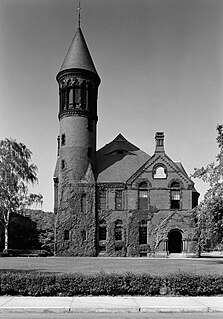
The Chelsea Parade Historic District encompasses a predominantly residential area north of downtown Norwich. Centered around the Chelsea Parade, a triangular public park, the area has long been a preferred residential area for the city's upper classes, and includes a catalog of architecture from the 18th to 20th centuries. It includes 565 contributing buildings, two other contributing sites, and six contributing objects over an area of 205 acres (83 ha). The district was listed on the National Register of Historic Places in 1989.

The Nathaniel Backus House is a two-story Greek Revival clapboarded house with a gable roof in Norwich, Connecticut. The house was built around 1750 by Nathaniel Backus and served as his home, it was later moved to its current location in 1952. The house originally began as a Colonial, but was greatly modified to Greek Revival around 1825, reconfiguring the central door to the left of the facade and adding two chimneys. The house is a historic house museum operated by the Faith Trumbull Chapter of the Daughters of the American Revolution.
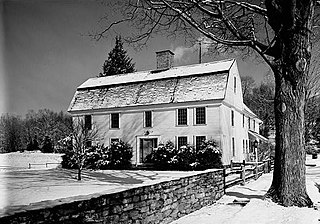
The Bradford-Huntington House is a historic house at 16 Huntington Lane in the Norwichtown section of Norwich, Connecticut, United States. The house was built in stages, beginning around 1691, and is one of the oldest to survive in the area. It was owned by American Revolutionary War officer Jabez Huntington. It is claimed that Huntington hosted George Washington here. The house was listed on the National Register of Historic Places in 1970. It is also a contributing property in the Norwichtown Historic District.

The Joseph Carpenter Silversmith Shop is a historic building that was built between 1772 and 1774 on the green in Norwichtown, now a section of Norwich, Connecticut. It is a 30 feet (9.1 m) by 24 feet (7.3 m) 1+1⁄2-story clapboarded building with a gambrel roof. The interior has a single brick chimney that was used for the forge, but it has been modified and adapted for modern use with modern doors, electric lighting and heat, and a disappearing overhead stairway that leads to the attic. Joseph Carpenter (1747–1804) was a successful of silversmith, clockmaker, and pewterer, and shared the building with his brother, a merchant. The shop was added to the National Register of Historic Places on October 6, 1970, and was listed as a contributory property for the Norwichtown Historic District on January 17, 1973.
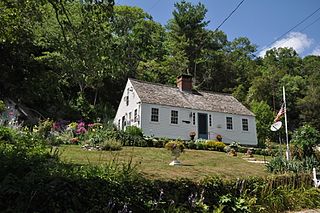
The Capt. Richard Charlton House is a historic house at 12 Mediterranean Lane in Norwich, Connecticut. Built about 1800, it is a well-preserved example of an early 19th-century cottage with vernacular style. The house was listed on the National Register of Historic Places in 1970.

The Leffingwell Inn is a historic inn at 348 Washington Street in the Norwichtown section of Norwich, Connecticut. With a construction history dating to 1675, it is one of Connecticut's oldest buildings, and was an important meeting place during the American Revolutionary War. The building was listed on the National Register of Historic Places in 1970.
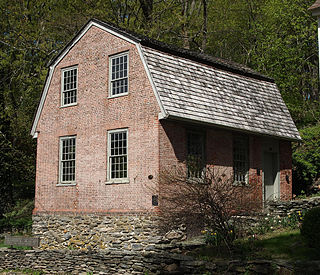
The East District School is a historic school building at 365 Washington Street in Norwich, Connecticut. Built in 1798, it is significant as a rare and well-preserved 18th-century schoolhouse, and as the location of an evening school for adults established by Consider Sterry, author of an early guide to practical navigation. The school was listed on the National Register of Historic Places in 1970, and is a contributing property to the Norwichtown Historic District.

The Gen. Jedidiah Huntington House is a historic house at 23 East Town Road in Norwich, Connecticut. Built in 1765, it is a good example of Georgian residential architecture, notable as the home of Jedidiah Huntington, a general during the American Revolutionary War. The house was listed on the National Register of Historic Places in 1970, and is a contributing property to the Norwichtown Historic District.

The Telephone Exchange Building is a historic building at 23 Union Street in downtown Norwich, Connecticut, behind Norwich Town Hall. Built in 1906-07, it was the first purpose-built telephone exchange building in the city, and is a little-altered example of period exchanges built by the Southern New England Telephone Company. The building now houses city offices. It was listed on the National Register of Historic Places on November 28, 1983.

The Little Plain Historic District is a predominantly residential historic district located in Norwich, Connecticut. When originally listed in 1970, it was centered on Little Plain Park, located about halfway between modern downtown Norwich and the Norwichtown green, the colonial center of the town. From the late 18th century onward this area became a desirable and fashionable area to live, as it was closer to the growing port area of the city. The area was mostly built out by about 1875, and features a rich concentration of Greek Revival, Gothic Revival and Italianate houses, although older and later styles are also represented. The district was listed on the National Register of Historic Places in 1970 and enlarged in 1987. The 1987 enlargement expanded the district southward along Union Street and Broadway, to abut the Downtown Norwich Historic District, and increased the district's size from 30 acres (12 ha) to 38.8 acres (15.7 ha).

The Dr. Daniel Lathrop School is a historic school building at 69 East Town Street in the Norwichtown section of Norwich, Connecticut. It is a single-story brick structure with a gambrel roof, located facing the village green next to the Joseph Carpenter Silversmith Shop, another historic building. Built in 1782, it is one of the oldest surviving brick school buildings in the state. The building was listed on the National Register of Historic Places on December 29, 1970. It now serves as a visitors center for the local historical society.

The Gov. Samuel Huntington House is a historic house at 34 East Town Street in Norwich, Connecticut. The house was built in 1783 by Samuel Huntington (1731–96), a signer of the United States Declaration of Independence and a Governor of Connecticut. It was listed on the National Register of Historic Places on October 6, 1970, and is a contributing property to the Norwichtown Historic District.

The Dr. Philip Turner House is a historic house at 29 West Town Street in Norwich, Connecticut. Possibly built in the late 17th century, it is one of the oldest houses on Norwich, and well-preserved example of vernacular architecture. At the time of the American Revolutionary War it was probably owned by Dr. Philip Turner, a leading surgeon for the Continental Army. It was listed on the National Register of Historic Places on October 15, 1970.

The Col. Joshua Huntington House is a historic house at 11 Huntington Lane in Norwich, Connecticut. Built in 1771, it is a well-preserved example of Georgian architecture in the city's Norwichtown area. It was built for Joshua Huntington, scion of a prominent family and a local military leader during the American Revolutionary War. The house was listed on the National Register of Historic Places on February 23, 1972.
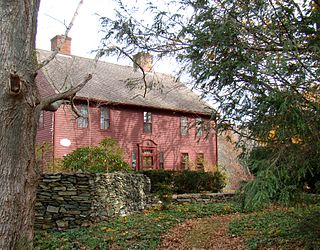
The Lathrop-Mathewson-Ross House is a historic house on Ross Hill Road in Lisbon, Connecticut. The house was built in 1761, and is a well-preserved example of Georgian residential architecture with an extensive documentary trail. It was added to the National Register of Historic Places on April 15, 1982.

The Captain Benjamin Williams House, also known as deKoven House or DeKoven Community Center, is a historic house at 27 Washington Street in Middletown, Connecticut. Built in the late 18th century, it is a particularly fine example of late Georgian architecture, and was listed on the National Register of Historic Places in 1978. It is now owned and operated by the Rockfall Foundation and operated as a community center.
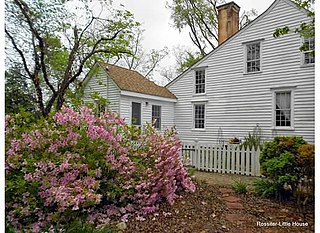
Rossiter-Little House is generally considered the oldest house in Sparta, Georgia. The present structure was built onto and around a log cabin (1797). The structure was built on the highest point in Sparta and used initially as a fort. Beneath the crawlspace of the present house, the original structure of the log foundation is still in place. The Rossiter-Little House was probably built about 1798 when Timothy Wells Rossiter, a Revolutionary War surgeon from Connecticut, bought the northeast corner lot at Broad and Miles Streets or the year after that when he bought the adjoining lot to the east. It is a contributing property of the Sparta Historic District, listed on the National Register of Historic Places in 1974. It is also part of the Historic American Buildings Survey.






















